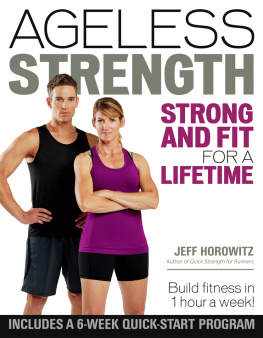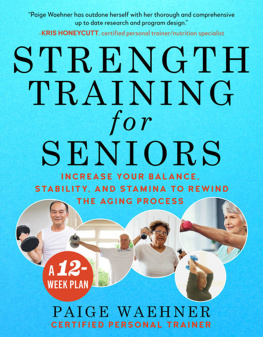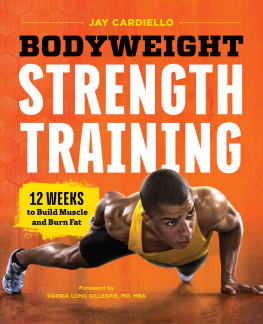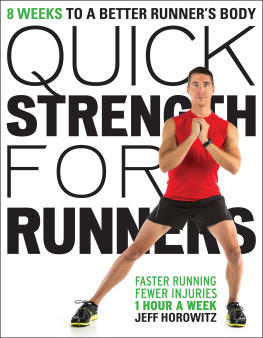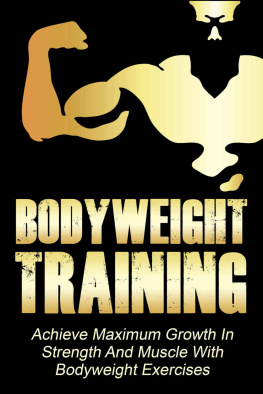

Copyright 2017 by Jeff Horowitz
All rights reserved. Published in the United States of America by VeloPress, a division of Competitor Group, Inc.

3002 Sterling Circle, Suite 100
Boulder, CO 803012338 USA
VeloPress is the leading publisher of books on endurance sports. Focused on cycling, triathlon, running, swimming, and nutrition/diet, VeloPress books help athletes achieve their goals of going faster and farther. Preview books and contact us at velopress.com.
Distributed in the United States and Canada by Ingram Publisher Services
A Cataloging-in-Publication record for the printed edition is available from the Library of Congress.
ISBN: 978-1-937715-71-7; eISBN: 978-1-937716-89-9
Art direction: Vicki Hopewell
Photography: Jason Innes, cover and interior, except for those by:
Cover design: Kristin Weber
Illustrations: Charlie Layton
v. 3.1
A note to readers: Double-tap on illustrations and figures to enlarge them. After art is selected, you may expand or pinch your fingers to zoom in and out.
CONTENTS
AGING BODIES, AGELESS STRENGTH
T heres a common belief that once we cross over the great divide of 40, the years bring only greater physical decline as we journey toward the big dirt sleep. Vitality drains away year by year as we sit idly by, like crabs in a pot of water over a flame. As we become more and more reliant on canes, wheelchairs, and caretakers, we lose strength, independence, and quality of life.
This isnt a pleasant view of the golden years. I dont buy it, and neither should you.
Yes, physical changes come along with age. But we dont have to accept all of these changes as inevitable, and we certainly dont have to give the Grim Reaper a helping hand before our time. With a little focused effort, we can maintain vitality and strength throughout our advancing years, and in some cases achieve the best fitness of our lives.
To understand how this can be true, we need to understand how the body works and the difference between our potential fitness and our actual fitness.
The body functions on a use it or lose it basis: Without a challenge to fight against, the body wastes away. This process is called atrophy, and its a natural law of conservation. What our bodies dont need, they lose. That includes muscle, bone, endurance, and fitness.
Luckily, it doesnt take a lot of work to keep our bodies working well. As we go about our daily routines, our bodies are being challenged in many ways, and they respond appropriately. Like a big city that never sleeps, the body is never truly at rest, despite appearances to the contrary. Every minute of every day, for example, our bodies fight off invading microbes. While we sleep, our bodies are in their highest repair mode, releasing human growth hormone to trigger the repair of damaged and injured tissue, and rebuild worn-out muscle and bone. If we had to monitor all of this activity consciously, wed be overwhelmed, but our bodies handle these monumental tasks in stride.
At least they do when were younger. As we get older, things begin to change. Our bodies begin to release less human growth hormone during our sleep, and we need more time to recover from big workouts.
Discouraged? Dont be, because thats not the full story. Even with a diminished capacity to repair, the body can always change for the better. At any age, it can respond to physical stimulithat is, exerciseby resculpting itself to handle a new challenge.
Consider this example: If a teenager and a 50-something both began a running program, each would probably feel a bit sore at first, but the older runner might need an extra day of rest every week. Yet after a month or two, theyd both find their earlier workouts to be much easier and would be ready for more challenging runs. During their weeks of training, both would experience a wide range of changes, whether they were aware of them or not. These would include an increase in blood volume to deliver more nutrients and oxygen to working muscles, an increase in the number of mitochondria in their muscle cells to deliver more energy to power contraction of muscle cells, and an increase in sweat rate so they could cool off more efficiently.
This is the essence of exercise: the gradual, measured overload of the bodys capacity to do work, which triggers an adaptation response. Work a little harder, and your body will change itself to make your job easier.
Heres the important point: That process is not limited to the young. It can occur any time, for anyone.
Unfortunately, this works in the other direction as well. If we fail to do the minimal amount of work necessary to trigger maintenance of our fitness, we lose the capacity to do that work. That, too, is true at any time, for anyone.
This phenomenon is perhaps most dramatically demonstrated by astronauts living on the International Space Station. Their bodies lose muscle mass and strength while they are in space since they no longer have to fight against the demands of gravity. These changes could compromise their long-term health and make their adjustment back to living on Earth difficult, so they spend hours of every 24-hour day tethered to fitness machines to keep as fit as they can.
For those of us stuck on Earth, the challenges are less dramatic but no less real. The demands of office jobs and the temptations of our virtual realitybased culture have made us increasingly sedentary, with the result that our bodies no longer feel pushed to maintain high levels of strength and fitness. This trend only accelerates as we enter middle age and beyond.
You might think that when faced with this situation, people would conclude that they need to become more active to restore health and vitality. But thats often not the case. Many people seem to believe that as they get older, they should be more careful about what they do and take even fewer chances with their bodies. Believing that exertion can bring strain and injury, they avoid challenging activities.
But as we now know, following this path leads to the exact opposite result. Instead of being safer and healthier by avoiding exercise, older people become less fit and more at risk for injury and disease. Their lifestyle then yields a self-fulfilling prophecy: They slow down because they think they should, given their age, and then their bodies lose fitness and slow down too.
Instead, they should ramp up their activity. They might need to be smarter about what they dothats what this book is all aboutbut middle age shouldnt mark the end of challenging activity. It should instead mark the start of the next chapter. In fact, rather than being a time of declining fitness, our mature years can be a time for improvement.
EXERCISE AND MENTAL HEALTH
Exercise improves physical strength, functionality, and quality of life, but thats not all. Scientists have now determined conclusively that regular exercise is also one of the most effective tools to improve mental health.
Anyone who has ever engaged in a regular exercise routine can attest to the generally improved sense of well-being that exercise bringsa version of the runners high that was first recognized during the running boom of the 1970s. Engaging in a regular exercise program often involves learning new skills and demonstrating commitment, which in turn raises self-esteem. Exercise has also been shown to improve sleep, reduce stress, and improve memory.

